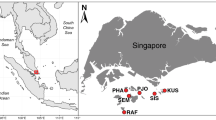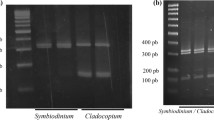Abstract
Studies on latitudinal gradients in Symbiodinium diversity on scleractinian corals are largely restricted to warm-water low latitude locations, and it appears that there is a shift in symbiont distributions with increasing latitude. The Symbiodinium assemblages of high latitude coral communities have largely been undocumented despite occupying an important transitional zone between tropical and temperate regions. Using a combination of the internal transcribed spacer region 2 (ITS2) and denaturing gradient gel electrophoresis (DGGE), we assessed the cladal and subcladal variability of Symbiodinium in the widely distributed species Stylophora pistillata along a latitudinal transect in southeast African waters which extended into high latitude locations. All colonies examined belonged to clade C. Six unique ITS2-DGGE banding profiles (designated Cspa to Cspf) were observed, which showed a latitudinal distribution from north to south, most likely a result of a gradient in water temperature and irradiance driven by riverine input in the southern regions. Sequence analysis revealed that all sequences except one did not match previously identified clade C sub-types, probably due to the lack of regional information in the Western Indian Ocean when compared to the Caribbean and Pacific. This study further supports the applicability of ITS2-DGGE in studies on Symbiodinium diversity, and highlights that potentially ecologically informative biogeographic patterns may be overlooked when only cladal designations are employed.



Similar content being viewed by others
References
Atoda K (1947) The larva and postlarval development of some reef-building corals. II. Stylophora pistillata (Esper). Science Reports Tohoku University 4th Series (Biol) 18:48–65
Baker AC (2003) Flexibility and specificity in coral–algal symbiosis: diversity, ecology, and biogeography of Symbiodinium. Annu Rev Ecol Ev Syst 34:661–689
Baker AC, Starger C, McClanahan T, Glynn P (2004) Corals’ adaptive response to climate change. Nature 430:741
Berg H, Francis J, Souter P (2002) Support to marine research for sustainable management of marine and coastal resources in the Western Indian ocean. Ambio 31:597–601
Burnett WJ (2002) Longitudinal variation in algal symbionts (zooxanthellae) from the Indian ocean zoanthid Palythoa caesia. Mar Ecol Prog Ser 234:105–109
Celliers L, Schleyer MH (2002) Coral bleaching on high-latitude marginal reefs at Sodwana Bay, South Africa. Mar Pollut Bull 44:1380–1387
Celliers L, Mann BQ, Macdonald AHH, Schleyer MH (2007) A benthic survey of the rocky reefs off Pondoland, South Africa. Afr J Mar Sci 29:65–77
Done TJ (1999) Coral community adaptability to environmental change at the scales of regions, reefs, and reef zones. Am Zool 39:66–79
Douglas AE (1998) Host benefit and the evolution of specialization in symbiosis. Heredity 81:599–603
Fabricius KE, Mieog JC, Colin PL, Idip D, van Oppen MJH (2004) Identity and diversity of coral endosymbionts (zooxanthellae) from three Palauan reefs with contrasting bleaching, temperature and shading histories. Mol Ecol 13:2445–2458
Hoegh-Guldberg O, Hinde R (1986) Studies on a nudibranch that contains zooxanthellae I. Photosynthesis, respiration and the translocation of newly fixed carbon by zooxanthellae in Pteraeolidia ianthina. Proc R Soc Lond B 228:493–509
Hughes TP, Bellwood DR, Connolly SR (2002) Biodiversity hotspots, centres of endemicity, and the conservation of coral reefs. Ecol Lett 5:775–784
Hunter RL, LaJeunesse TC, Santos SR (2007) Structure and evolution of the rDNA internal transcribed spacer (ITS) region 2 in the symbiotic dinoflagellates (Symbiodinium, Dinophyta). J Phycol 43:120–128
Iglesias-Prieto R, Matta JL, Robins WA, Trench RK (1992) Photosynthetic response to elevated-temperature in the symbiotic dinoflagellate Symbiodinium microadriaticum in culture. Proc Natl Acad Sci USA 89:10302–10305
Iglesias-Prieto R, Beltran VH, LaJeunesse TC, Reyes-Bonilla H, Thome PE (2004) Different algal symbionts explain the vertical distribution of dominant reef corals in the eastern Pacific. Proc R Soc B 271:1757–1763
Kleypas JA, McManus JW, Menez LAB (1999) Environmental limits to coral reef development: where do we draw the line? Am Zool 39:146–159
LaJeunesse TC (2002) Diversity and community structure of symbiotic dinoflagellates from Caribbean coral reefs. Mar Biol 141:387–400
LaJeunesse TC (2005) Species radiations of symbiotic dinoflagellates in the Atlantic and Indo-Pacific since the Miocene–Pliocene transition. Mol Biol Evol 22:570–581
LaJeunesse TC, Trench RK (2000) Biogeography of two species of Symbiodinium (Freudenthal) inhabiting the intertidal sea anemone Anthopleura elegantissima (Brandt). Biol Bull 199:126–134
LaJeunesse TC, Loh WKW, van Woesik R, Hoegh-Guldberg O, Schmidt GW, Fitt WK (2003) Low symbiont diversity in southern Great Barrier Reef corals, relative to those of the Caribbean. Limnol Oceanogr 48:2046–2054
LaJeunesse TC, Bhagooli R, Hidaka M, deVantier L, Done T, Schmidt GW, Fitt WK, Hoegh-Guldberg O (2004) Closely related Symbiodinium spp. differ in relative dominance in coral reef host communities across environmental, latitudinal and biogeographic gradients. Mar Ecol Prog Ser 284:147–161
Lien Y-T, Nakano Y, Plathong S, Fukami H, Wang J-T, Chen CA (2007) Occurrence of the putatively heat-tolerant Symbiodinium phylotype D in high-latitudinal outlying coral communities. Coral Reefs 26:35–44
Loh WKW, Loi T, Carter D, Hoegh-Guldberg O (2001) Genetic variability of the symbiotic dinoflagellates from the wide ranging coral species Seriatopora hystrix and Acropora longicyathus in the Indo-West Pacific. Mar Ecol Prog Ser 222:97–107
McClanahan TR, Maina J, Moothien-Pillay KR, Baker AC (2005) Effects of geography, taxa, water flow, and temperature variation on coral bleaching intensity in Mauritius. Mar Ecol Prog Ser 298:131–142
Macdonald AHH (2005) The tramp coral, Stylophora pistillata, in the south–west Indian Ocean: ecomorph or speciation. MSc thesis, University of KwaZulu-Natal, South Africa
Randall JE (1998) Zoogeography of shore fishes of the Indo-Pacific region. Zool Stud 37:227–269
Reynolds RW, Smith TM (1994) Improved global sea surface temperature analyses. J Clim 7:929–948
Ridgway T, Sampayo EM (2005) Population genetic status of the Western Indian Ocean: What do we know? WIO J Mar Sci 4:1–9
Ridgway T, Hoegh-Guldberg O, Ayre DJ (2001) Panmixia in Pocillopora verrucosa from South Africa. Mar Biol 139:175–181
Ridgway T, Riginos C, Davis J, Hoegh-Guldberg O (2007) Pocillopora verrucosa genetic connectivity patterns in Southern African Marine Protected Areas. Mar Ecol Prog Ser In press
Rocha LA, Craig MT, Bowen BW (2007) Phylogeography and the conservation of coral reef fishes. Coral Reefs 26:501–512
Rodriguez-Lanetty M, Loh WKW, Carter D, Hoegh-Guldberg O (2001) Latitudinal variability in symbiont specificity within the widespread scleractinian coral Plesiastrea versipora. Mar Biol 138:1175–1181
Rowan R, Powers DA (1991) Molecular genetic identification of symbiotic dinoflagellates (zooxanthellae). Mar Ecol Prog Ser 71:65–73
Rowan R, Knowlton N (1995) Intraspecific diversity and ecological zonation in coral algal symbiosis. Proc Natl Acad Sci USA 92:2850–2853
Sambrook J, Russell DW (2001) Molecular cloning: a laboratory manual 3rd edn. Cold Spring Harbor Laboratory Press, New York
Sampayo EM, Franceschinis L, Hoegh-Guldberg O, Dove S (2007) Niche diversification of closely related symbiotic dinoflagellates. Mol Ecol 16:3721–3733
Swofford DL (1999) PAUP*, phylogenetic analysis using parsimony (*and other methods), version 4.0b10, Sinauer Associates, Sunderland
Thompson JD, Gibson TJ, Plewniak F, Jeanmougin F, Higgins DG (1997) The ClustalX windows interface:flexible strategies for multiple sequence alignment aided by quality analysis tools. Nucleic Acids Res 24:4876–4882
Thornhill DJ, LaJeunesse TC, Kemp DW, Fitt WK, Schmidt GW (2006) Multi-year, seasonal genotypic surveys of coral–algal symbioses reveal prevalent stability or post-bleaching reversion. Mar Biol 148:711–722
Thornhill DJ, LaJeunesse TC, Santos SR (2007) Measuring rDNA diversity in eukaryotic microbial systems:how intragenomic variation, pseudogenes, and PCR artifacts confound biodiversity estimates. Mol Ecol 16:5326–5340
Toller WW, Rowan R, Knowlton N (2001) Zooxanthellae of the Montastraea annularis species complex: patterns of distribution of four taxa of Symbiodinium on different reefs and across depths. Biol Bull 201:348–359
van Oppen MJH, Palstra FP, Piquet AMT, Miller DJ (2001) Patterns of coral–dinoflagellate associations in Acropora:significance of local availability and physiology of Symbiodinium strains and host–symbiont selectivity. Proc R Soc Lond B 268:2617–2617
van Oppen MJH, Mahiny AJ, Done TJ (2005) Geographic distribution of zooxanthella types in three coral species on the Great Barrier Reef sampled after the 2002 bleaching event. Coral Reefs 24:482–487
Veron JEN (1993) A biogeographic database of hermatypic corals: Species of the Central Indo-Pacific, Genera of the World. Australian Institute of Marine Science Monograph Series 10. 433 pp
Visram S, Douglas AE (2006) Molecular diversity of symbiotic algae (zooxanthellae) in scleractinian corals of Kenya. Coral Reefs 25:172–176
Warner ME, LaJeunesse TC, Robison JE, Thur RM (2006) The ecological distribution and comparative photobiology of symbiotic dinoflagellates from reef corals in Belize: potential implications for coral bleaching. Limn Oceanogr 51:1887–1897
Acknowledgments
Thanks are extended to Prof. Ove Hoegh-Guldberg for financial support and laboratory usage, Dr. M. Meusel for use of laboratory facilities, Dr. L. Celliers for manuscript feedback, and SAAMBR and the NRF for an MSc scholarship to AM.
Author information
Authors and Affiliations
Corresponding authors
Additional information
Communicated by M.I. Taylor.
Rights and permissions
About this article
Cite this article
Macdonald, A.H.H., Sampayo, E.M., Ridgway, T. et al. Latitudinal symbiont zonation in Stylophora pistillata from southeast Africa. Mar Biol 154, 209–217 (2008). https://doi.org/10.1007/s00227-008-0915-1
Received:
Accepted:
Published:
Issue Date:
DOI: https://doi.org/10.1007/s00227-008-0915-1




